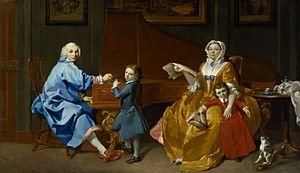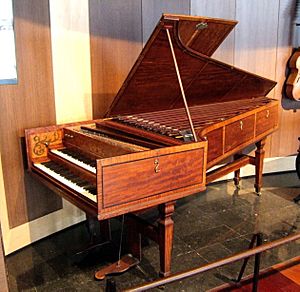Burkat Shudi facts for kids
Burkat Shudi (sometimes spelled Burkhart or Burkhardt) (born March 13, 1702 – died August 19, 1773) was a famous English maker of harpsichords. A harpsichord is an old musical instrument. It is a bit like a piano, but it plucks strings instead of hitting them. Burkat Shudi was originally from Switzerland. He became one of the most important harpsichord makers of his time.
The Story of Burkat Shudi
Burkat Shudi was born in a place called Schwanden in Switzerland. He moved to England in 1718 when he was about 16 years old. He started working as a joiner, which is someone who makes things by joining pieces of wood.
In 1728, he married Catherine Wild. Her family was from the same town in Switzerland as him. Later, a man named John Broadwood started working for Shudi in 1761. John Broadwood married Shudi's daughter, Barbara, in 1769. After that, John Broadwood became Shudi's business partner.
Burkat Shudi retired in 1771. His son, also named Burkat, took over the business. After the son passed away in 1803, John Broadwood took over the company completely. Broadwood later became famous for making pianos.
Today, we know of 23 harpsichords made by Burkat Shudi himself. There are also 27 harpsichords made by Shudi and Broadwood together.
Shudi's Amazing Harpsichords

Shudi's harpsichords were inspired by the old traditions from Flanders. This area was famous for harpsichord makers like Ruckers. Ruckers' harpsichords were very valuable in the 1700s. Shudi even owned two Ruckers harpsichords himself.
Shudi made many new improvements to the harpsichord. Around 1765, he added something called the "machine stop." This was a special tool operated by a foot pedal. It could slowly change the sound of the instrument. Also around 1765, he made the range of notes lower.
Around 1769, he introduced the "Venetian swell." This was a clever device that worked like the expression pedal on an organ. It was also operated by a foot pedal. It allowed the player to make the sound louder or softer.
Many famous people loved Shudi's harpsichords. The musician Charles Burney thought Shudi's instruments sounded better than others. Some of his famous customers included Frederick the Great, Empress Maria Theresa, and the composer Joseph Haydn. Even Wolfgang Amadeus Mozart tried one of his harpsichords in 1765.
Shudi's harpsichords were sent to many countries. They went as far as Russia, Portugal, and Italy. In Naples, Italy, one of his harpsichords was called a "musical wonder."
A famous expert named Frank Hubbard once said that Shudi's harpsichords were among the best ever made. He said they had magnificent sound. They had clear high notes and deep, rich low notes.
See also
- List of historical harpsichord makers
- A Shudi harpsichord is mentioned in the science fiction book Worlds Enough and Time by Joe Haldeman.



